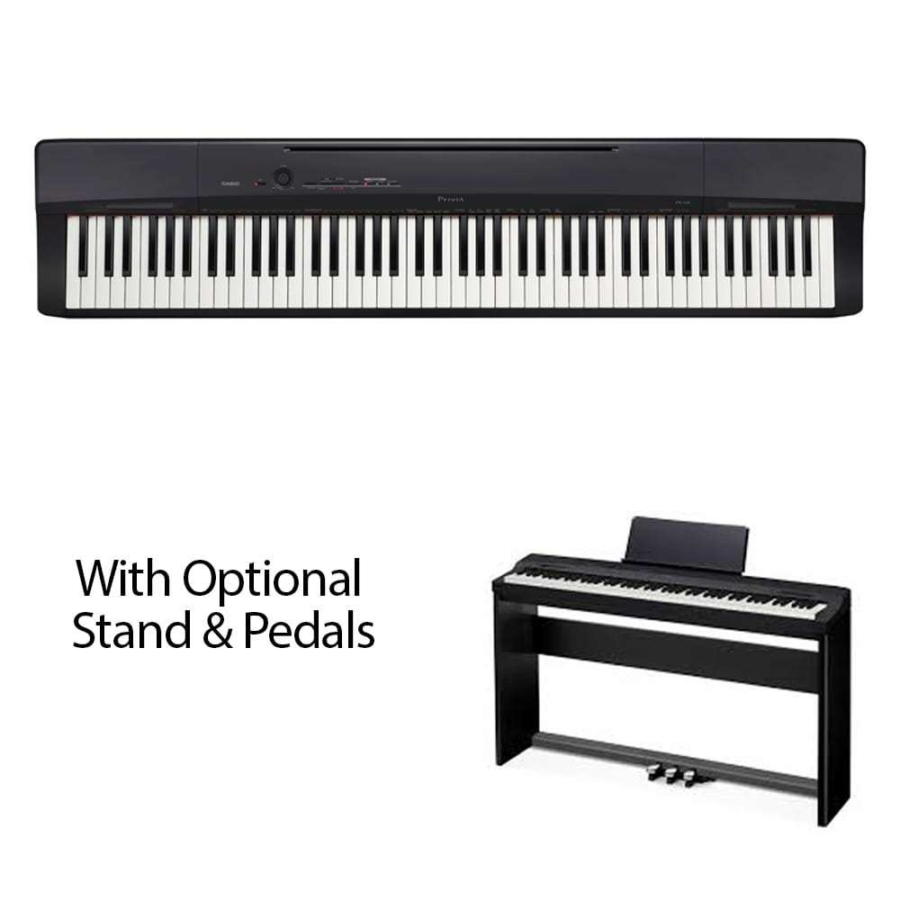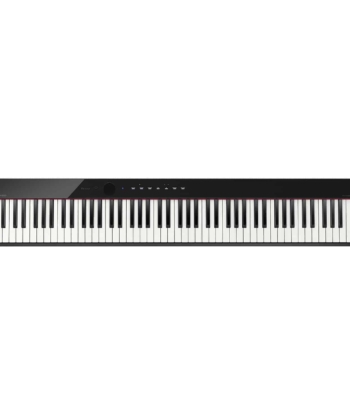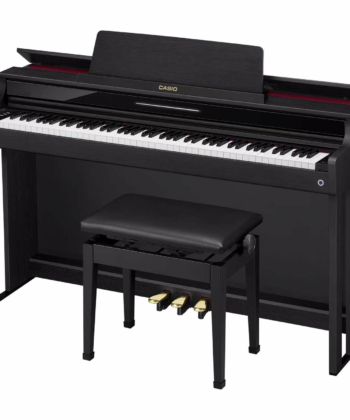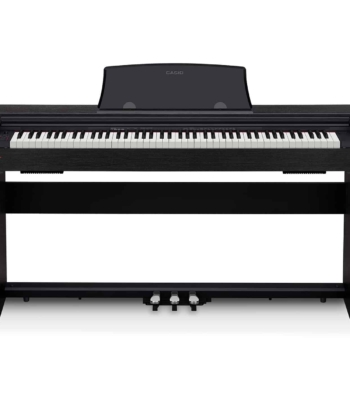Description
Product Overview
Going back as little as a mere decade ago, and the $500 USD class of portable digital pianos offered instruments that while serviceable, were not viewed as a legitimate practice option for those trying to learn piano.
When the Casio Privia PX-160 hit the market, it single handedly changed the digital piano market almost overnight. Finally, an extremely affordable portable digital piano with good sound and touch. This caused the ‘big 3’ of Roland, Kawai and Yamaha to play catch up, and firmly expanded the ‘big 3’ into a ‘big 4’.
With Casio‘s proprietary sound source and agile action, the PX160 satisfied legions of piano players during an extremely successful production run.
Piano Sound/Tone Engine
The PX160BK features Casio’s award winning Acoustic and Intelligent Resonator, or, AiR sound source for short. Dimensional AiR is a sample based tone engine built off the recording of a 9 foot concert grand at 4 dynamic levels, with some additional synthesis of Damper Resonance, Hammer Response, Damper Noise added in. Polyphony is 128 notes, which is great for the price point, and the grand piano sounds/piano tones are much better than anything else at the price when the PX160 first came out. This is a stripped down version of the engine found in Casio’s PX-5S Stage Piano.
The on-board speaker system has inherent limitations, but that can be overcome by playing with headphones for better sound quality.
Beyond the piano tones, the electric pianos, harpsichords, string ensembles and organs, among others, all sound solid. The other big 3 manufacturer’s have all responded with great alternatives in this price point, but Casio really did the raise the bar from sound standpoint with the PX160.
Action
The PX-160 features Casio’s remarkable Tri-Sensor Scaled Hammer Action II keyboard. Again, this was another huge breakthrough as it was the first time an action had been equipped with a triple sensor in this price point, and a big improvement over Casio’s previous generation action. A triple sensor offers more sensitivity levels than the dual sensors most common in instruments at this price point. While Roland and Kawai have since come out with actions in the class that feel better (still at least $100 more expensive) this is still a very solid action for learning piano, practicing or performing.
In terms of the touch, Casio went with simulated ebony and ivory key surfaces to replicate the incredible feel and texture of an acoustic piano.
Connectivity
All of the basics are covered in terms of connectivity. There’s dual line left and right line outputs (1/4″ L/MONO, R), 2 headphone jacks, a damper pedal input (sustain pedal), a 3-pedal unit connector (for the optional SP33 pedal system) and a USB port to host which allows you to connect the PX160 to an Apple iPad, Mac, Windows Computers or other such device.
Features
While the Casio PX-160 isn’t as loaded up from a features standpoint as some of their more expensive models, it certainly has everything you’ll need for the types of applications this instrument is built for. Certain features that stand out are a 2 track recorder and distinct line outputs, making the PX160 a legitimate gigging/rehearsal instrument.
- Multi Dimensional Morphing AiR Sound Source
- Tri-Sensor Scaled Hammer Action II keyboard
- Reverb
- Duet Mode (splits the keyboard into two equal ranges)
- Layer Capability
- Split for Different Sounds in Right and Left Hands
- Octave Shift
- Dual Headphone Outputs
- USB Connectivity
- Removable Music Stand
- Optional Compatible Keyboard Stand (CS-67 Stand)for an Elegant Look
- AC Adaptor
The Casio Privia PX-160 digital piano is loaded with all the typical digital piano necessities: metronome, transpose, several playing modes to layer and split the keyboard, and a basic recorder function. It also has MIDI in/out, and somewhat surprisingly, independent audio line outs (¼”) so amps and stereos can be hooked up without having to run cables out of the headphone jack.
Casio PX-160 Owner’s Manual
- [English] PX160 Owner’s Manual
Casio PX-160 Related Resources
- Casio Privia PX160 Demo & Review – AiR Sound Source & Tri-Sensor Scaled Hammer Action II
- Yamaha P45 vs Casio Privia PX-160 Digital Piano Review, Demo, & Comparison
- Best Digital Pianos Under $500 in 2020 – PX-160, FP-10, P45
Specifications
| Keyboard | 88 keysweighted scaled hammer action 3 sensitivity levels, off Simulated ebony and ivory keys |
| Sound Source | Multi-dimensional Morphing AiR Sound Source Stereo-sampled Piano Tones |
| Polyphony (maximum) | 128 |
| Tones | 18 Built-in tones:
Grand Piano (Concert, Modern, Classic, Mellow, Bright) |
| Simulator | Hammer Response* Damper Noise*Damper Resonance* |
| Digital Effects | Hall Simulator/Reverb – 4 (Reverb) Chorus – 4 Brilliance – -3 ~ 0 ~ +3DPS – Yes (Preset for some tones) |
| Accompaniment | 60 Song Music Library10 song expansion (max) / Approximately 90 KB/song |
| MIDI Recorder | 2 Tracks / 1 song |
| MIDI Data Capacity | Approximately 5,000 notes total** |
| Duet Mode | Yes (Duet Pan On/Off) |
| Octave Shift | ±2 octaves |
| Metronome | 0, 2, 3, 4, 5, 6 beats; tempo range: 20 to 255 |
| Pedals | Included : SP-3 (terminal 1) Optional : SP-33 (damper, soft, sostenuto) Half-Damper pedal Operation – Yes (with optional SP-33 3-pedal unit) |
| Key Transpose | 2 octaves (-12 semitones ~ 0 ~ +12 semitones) |
| Tuning Control | A4 = 415.5Hz ~ 440.0Hz ~ 465.9Hz |
| Lesson Function | Part ON / OFF |
| Metronome | Yes |
| Scale-Function | 17 Preset Temperaments |
| Operation Lock | Yes |
| Pedals | Included: SP-3 Optional: SP-33 Half-Damper pedal Operation Yes (with optional SP-33) |
| Auto Power Off | After approx. 4 idle hours |
| MIDI*** | Yes |
| Phones | 2 on Front (Stereo Mini) |
| Pedal | 1 (Damper) |
| Connection for optional 3-Pedal Unit | Yes (SP-33) |
| Line Out | 1/4″ L/Mono, R |
| USB port (to Host) | Yes |
| Speaker Size | 4.7″ x 2 |
| Amplifiers | 8 W + 8 W |
| Size Dimensions | 52″ x 11.5″ x 5.6″ (w/o music stand) |
| Size Dimensions with Optional Keyboard Stand | 52″ x 11.5″ x 30.2″ |
| Weight | 25.5 lbs (w/o music stand) |
| Weight with Optional Keyboard Stand | 46.5 lbs |
| Included Accessories | Pedal (SP-3), AC Adaptor (AD-A12150), Music Stand |
| Optional Accessories | 3 Pedal System (SP-33), Keyboard Stand (CS-67) |
| PX-160BK UPC | 79767362195 |
| PX-160GD UPC | 79767362201 |
Additional Information
| Weight | 40 lbs |
|---|---|
| Dimensions | 57.5 × 14.5 × 8 in |








Reviews
There are no reviews yet.